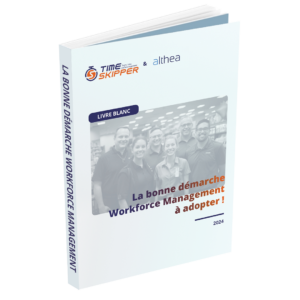In the retail industry, proper use of working hours has become essential to provide the best possible service to customers and guarantee the store’s profitability. Managing this “good use of working hours” means ensuring that each employee is busy doing the right task, in the right way, at the right time and for the right length of time! This is a vast programme, the starting point of which is to have a repository of time-worth tasks based on in-store operation expertise, know-how and timekeeping techniques!
By timing, we mean the correct measurement of the time each task will (and must) take to be carried out at a regular pace, neither too fast nor too slow. This involves defining reference times called average unit times or standard times.
Task repository, data analysis, calculation of average unit times, and other elements to improve the store: Timeskipper provides you with the keys to a successful timekeeping campaign and all its expertise.
RIGOROUS PREPARATION FOR RELEVANT AND USABLE TIMING
The preliminary work is just as important as the timing itself. First, it’s essential to understand the organisation and know the activities that make it what it is. We’re talking about the tasks and operations that make up each process, such as stocking shelves, receiving goods, advising sales, etc. This exercise makes it possible to define a particular set of tasks, which is crucial to correctly implement the approach. Timeskipper has a specialised tool for modelling task repository and ensuring timekeeping efficiency and recording time measurements, task by task.
Now, it’s time for observation! There are no timing tasks without good business. This would be counterproductive! Be careful, with the way these observations are carried out. Indeed, participants must follow certain methodological fundamentals:
- Transparent and practical communication to employees (previously informed by their superiors) about the “why and how” of observation and timing exercises.
- A “knowing how to observe from a distance and for long enough” so that the employee forgets the exercise and works at a normal pace, the objective being that the averages are as close to reality as possible.
Timeskipper’s added value? A method to support and observe teams goes far beyond “pure and simple” timekeeping. This know-how provides a clear view of how tasks are carried out, identifies malfunctions, and determines the levers for improvement to (re)implement good practices.
With Timeskipper, the recommendations are always factual and well adapted to the teams.
DATA PROCESSING AND ANALYSIS
The data recovery and processing stages are crucial because the Timeskipper platform algorithm uses average unit times to calculate the workload per operation or activity. And these times are themselves calculated from the timekeeping data, hence the importance of having a sufficient sample of statistical measurements for the average to be accurate and represent reality. Moreover, the sample is frequently clipped: 5% of the highest and lowest data are removed to neutralise behaviour that is too far from the average. Since the objective is to achieve a low standard deviation and be as close as possible to real conditions, a distinction should be made between activities requiring a large sample of data and those allowing fewer measurements.
In specialised distribution, for example, the questions asked by customers will vary the processing time from two to forty minutes: the sample will have to be large to be accurate.
Other activities, however, are repetitive, and the times are very similar from one measurement to another, such as putting canned vegetables on the shelf. The timing of this activity includes measuring the time taken to pick up and open the package, put it on the shelf, face it and break the box. And while it is quite simple to have times that represent reality, it’s important to take into account the factors that impact these times:
1- Method (catching, opening, putting on the shelf, breaking)
2- Packaging items (PCB): for 24 products, a carton of 24 boxes and 4 boxes of 6 boxes do not have the same processing time. This is a very important element that is checked on the product families to determine consistency in the databases.
3- Product family: canned vegetables, for example, will take less time to put on the shelf than canned fish, as the packaging is smaller, and the latter will take longer to handle. Another example is that fragile and light products such as crisps have different typologies to pasta or rice and, therefore, other processing times.
In this respect, the Timeskipper tool considers the nature of the analysed activity and goes down to the food industry’s sub-families to calculate the most accurate workload.
TIMEKEEPING WITH TIMESKIPPER
As we have seen, to calculate the workload, careful timing is essential to define the average unit times of activities that enter the settings used by the platform. But not only that! Once this valuable information is available, the Timeskipper solution opens a new field of possibilities for transforming organisations!
1) Timekeeping to benchmark points of sale
As part of an audit before implementing the Timeskipper tool, it’s possible to time several store activities in the same chain, produce averages for each store and compare their performance, mainly to compare different working methods.
In this respect, Timeskipper has access to the time bases of various food, DIY, sports, and pharmacy retailers, etc. Valuable information, consolidated over the last ten years, which we have used to support key players.
2) Timing to measure a team occupancy rate
When measuring the time of an activity, there can be many unexpected delays. There are two different types of delays and must be resolved differently:
- avoidable and inappropriate delays (personal discussions, use of smartphones, unnecessary and repetitive travel): they raise the issue of team occupancy rates. In this case, measuring the working time rate is necessary to optimise it later. These delays are excluded from the averages and must be corrected by management.
- Unavoidable delays: whether they’re the result of a question from a customer, a manager, unscheduled tidying, or cleaning, they’re inherent to the activity. These delays slow down productivity, but they are considered, timed, and added to the average unit time.
3) Timing to size up a “one-shot” organisation
If the organisational model changes, you need to know the number of people required to cover the difference in the scope of each team. Based on the initial measurements, supplemented by the timing of any additional activities, it’s possible to simulate the new organisation and define the necessary target size.
This is how the correct number of people will be defined to achieve the workload intended for the transformation.
4) Timing to measure a return on investment
In the case of work method optimisation or a change of organisation, the timing of the initial process will be compared with good practice (e.g., shelving with unpacking vs shelving without unpacking).
This comparison factualises potential gains to the management team and accelerates the transformation.
Conclusion
If we had to remember only one thing, it would be that without an average unit time, and therefore without defining a level of productivity upstream, it’s impossible to calculate a workload.
In addition to the platform’s features for calculating and managing the sales teams’ workload, Timeskipper has genuine expertise in the field of timekeeping: the approach, the tools, the data processing capacity, and the methods for compiling averages.
Moreover, continuous improvement and time saving to which companies are subject require that timekeeping be reviewed regularly. Unit times must be adjusted to the organisation’s development, methods, and technological tools so that the calculated workload is the most accurate and productivity is always optimal. So, whatever the reason for launching a timekeeping campaign, the Timeskipper team will support you and adapt to the company’s specificities and evolution.






